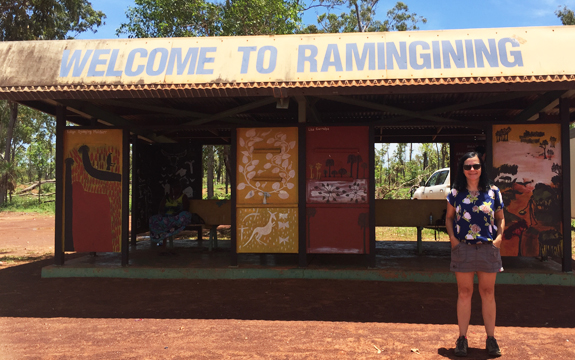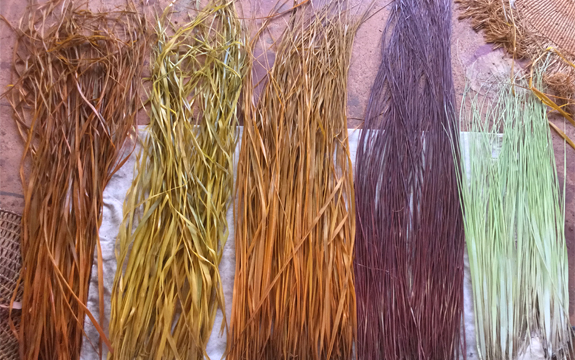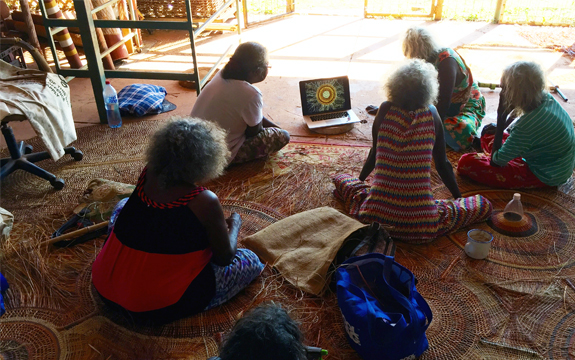Digital place-making in the Northern Territory

In Summary
- Dr Edwards-Vandenhoek spends time in Nothern Territory town of Ramingining
- Works on a digital place-making project that explores how Indigenous artwork and crafted products can be shared in new media forms
- Uses the town’s annual music festival as a way to share the work of the community arts centre
A desire to learn more about Indigenous art and design practices has taken senior lecturer in communication design, Dr Samantha Edwards-Vandenhoek, to the Northern Territory where she has worked with the Yolngu community of Ramingining.
Located more than 400km east of Darwin, Dr Edwards-Vandenhoek spent two weeks working closely with artists at the Bula’bula Arts Centre, she explored how their artwork and crafted products could be shared in new media forms, using digital place-making practices.
“Digital place-making includes large scale projections, outdoor screenings and public installations, Dr Edwards-Vandenhoek says.
“It’s a way to make connections, explore community capacity, strengthen culture, build social capital and drive innovation.”
Innovative digital arts project
She used Ramingining’s Bak’bididi Festival, the town’s annual music festival, as a way to share the work of the community arts centre. This involved producing a digital animation of traditional Indigenous weaving and projecting it onto the side of a building.

Animated digital projection of Margaret Malibirr’s woven floor mats
“The practice of weaving is something that Yolngu women have been doing for thousands of years.
“Through the recording and projection of their work, we were able to give people another way of reinforcing and connecting with their culture, community and its stories.
“Using technologies such as projections is a great way to test out ideas, start dialogues and build relationships that may lead to longer term collaborations. It can also provide a platform to capture and express deep connections to the land, people and the place they live in.”
In order to best represent the traditional process of weaving, Dr Edwards-Vandenhoek spent time learning the traditional weaving practices of the region.

Naturally stripped and dyed pandanus
“I was fortunate enough to go out with these women, into the bush, and follow their process of collecting the weaving materials and bringing them back into the art centre and transforming them into intricate woven baskets, jewellery, dilly bags and mats.
“It’s an extensive process and one that requires hard work, patience and time. It involves chopping down the young pandanus, searching for and digging out tree roots and plants that form the basis of various bush dyes, slicing the pandan leaves into fine strips, colourising, drying and then weaving.

Weavers previewing the digital projections of their designs
Developing an interest in Indigenous place-making
Dr Edwards-Vandenhoek has been working in the Indigenous design space for more than three years. Her current focus is on the advancement of Indigenous design, enterprise and innovation, more broadly.
In June 2016 Dr Edwards-Vandenhoek, as part of her HEPP funded Marngo Designing Futures program, ran a week long design camp at Lake Mungo and a two-day design workshop at Swinburne’s Hawthorn campus for high-school aged Indigenous students across Victoria. The program aims to build leadership capacity, stimulate interest and raise awareness of vocational and higher education in design.
In 2015 she travelled to the Western Australian town of Warmun for one month, where she spent time working with the Gija community, exploring inclusive design processes.
Indigenous Studies Small Research Projects Scheme
Dr Edwards-Vandenhoek received a $4,000 grant from Swinburne’s Indigenous Studies Small Research Projects Scheme, which she used fund her trip to the Northern Territory.
The scheme was created in 2016 to foster community and university collaborative research and to support Indigenous researchers.

